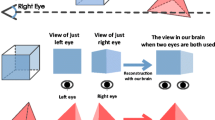Abstract
We propose a method for moving the view position to the origin and moving the coordinates of primitives so that they are at the same distance in order to improve ray-tracing precision. This approach exploits the principle that a floating-point number provides higher precision near zero. In this way, we can significantly reduce the number of self-intersections occurring in ray tracing that are caused by limited floating-point precision. The experimental results show that the number of self-intersections is reduced by up to 84.6 %. We also propose a hardware approach to resolve the computational overhead in the proposed algorithm. Its contribution to the hardware size is very small in comparison with the size of the entire ray-tracing hardware.








Similar content being viewed by others
References
Dammertz H, Keller A (2006) Improving ray tracing precision by object space intersection computation. In: Proceedings of the 2006 IEEE symposium on interactive ray tracing, pp 25–32
Game institute. http://www.gameinstitute.com/game-development/. Accessed 1 April 2014
Glassner A (ed) (1989) An introduction to ray tracing. Academic Press Ltd
Goldberg D (1991) What every computer scientist should know about floating-point arithmetic. ACM Comput Surv (CSUR) 23:5–48
Hanika J (2007) Fixed point hardware ray tracing, dissertation, Ulm University
Heinly J, Recher S, Bensema K, Porch J, Gribble C (2009) Integer ray tracing. Journal of Graphics, GPU, and Game Tools 14:31–56
IEEE standard for binary floating-point arithmetic for microprocessor systmes ANSI/IEEE Std. 754 (1985)
Ize T (2013) Robust BVH ray traversal. Journal of Computer Graphics and Techniques 2(2):12–27
Keely S (2014) Reduced precision hardware for ray tracing. High Performance Graphics, pp 29–40
Nah JH, Kwon HJ, Kim DS, Jeong CH, Park J, Han TD, Manocha D, Park WC (2014) RayCore: A ray-tracing hardware architecture for mobile devices. ACM Trans Graph 33(5):162
Park WC, Nah JH, Park JS, Lee KH, Kim DS, Kim SD, Park JH, Kim CG, Kang YS, Yang SB, Han TD (2008) An FPGA implementation of whitted-style ray tracing accelerator. IEEE Symposium on Interactive Ray Tracing:187–187
Pharr M, Humphreys G (2004) Physically based rendering from theory to implementation. Morgan Kaufmann Publishers
Suffern K (2007) Ray tracing from the ground up. A K Peters
Wald I (2004) Realtime ray tracing and interactive global illumination. Dissertation, Sarrland University
Whitted T (1980) An improved illumination model for shaded display. Commun ACM 23(6):343–349
Acknowledgments
This research was supported by Basic Science Research Program through the National Research Foundation of Korea (NRF) funded by the Ministry of Education, Science and Technology (NRF-2012R1A1A2004624).
Author information
Authors and Affiliations
Corresponding author
Rights and permissions
About this article
Cite this article
Kim, D., Nah, JH. & Park, WC. Geometry transition method to improve ray-tracing precision. Multimed Tools Appl 75, 5689–5700 (2016). https://doi.org/10.1007/s11042-015-2534-4
Received:
Revised:
Accepted:
Published:
Issue Date:
DOI: https://doi.org/10.1007/s11042-015-2534-4




